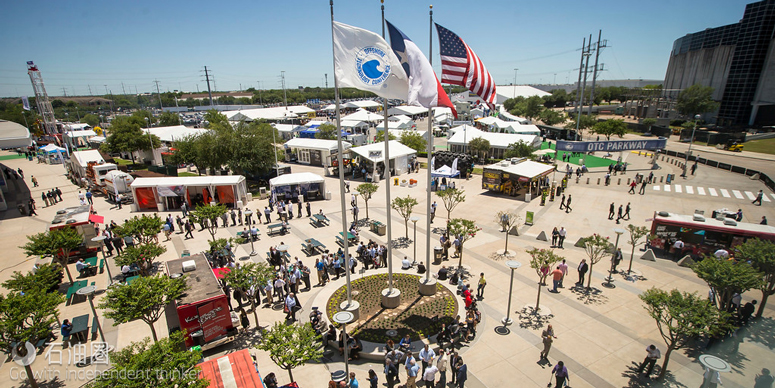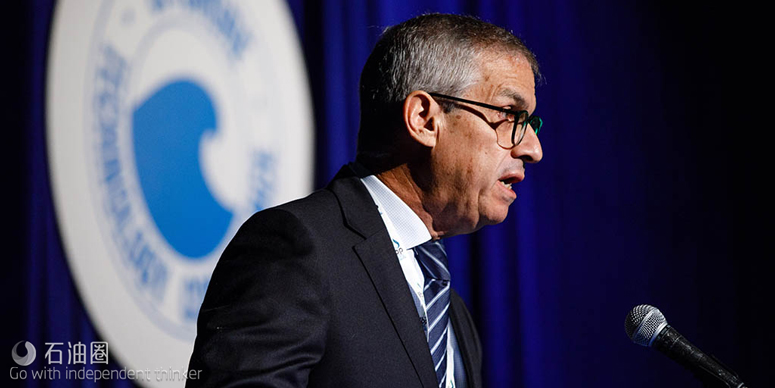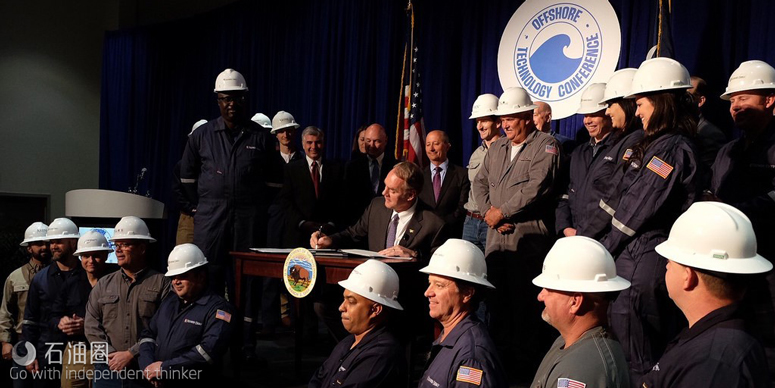One of the most important questions being asked at this year’s Offshore Technology Conference (OTC) is how deepwater projects can compete with shale developments. The answer, according to at least one executive, is for the deepwater sector to become more like the shale business.
Roger Jenkins, chief executive officer of independent producer Murphy Oil, said it is not necessarily about technology transfer. “It’s an attitude around needing to have continuous improvement, and that is what onshore has brought to the table,” he explained. “Every day, you have to improve and go faster.”
Speaking before hundreds of oil and gas professionals in Houston on Tuesday, Jenkins stressed that more synergies are needed between these two arenas, not so much to benefit shale production, but to protect the investment viability of deepwater, which he said needs higher margins of returns than shale due to the risk factor.
Murphy Oil is one of the few US independents that maintains a balanced portfolio of shale fields in North America and deepwater operations offshore southeast Asia and in the US Gulf of Mexico.
Jenkins said the company’s hybrid model has helped the “unconventional mindset” migrate into its deepwater operations. However, he pointed out a number of areas where this attitude has yet to take form. The list of shale sector attributes that need to cross over included: shorter production cycle times, a trend of lowering costs, greater field efficiencies, and the use of commonly available types of equipment.
There has been one critical area where both the unconventional and offshore sector have recently become similar: drilling times. Jenkins shared that benchmark offshore drilling times have improved from 8 days per 1,000 ft. drilled a few years ago to just over 4 days per 1,000 ft today. “The percent of improvement that is taking place onshore, is taking place offshore as well,” he said.
Aside from this bright spot, improvements on several other fronts Jenkins highlighted will be needed within the next 2 to 3 years; the amount of time he believes an upward shift in global crude prices could occur—something that would drive greater offshore activity and thus higher capital costs.
A Call To Drill
Fresh off being awarded an exploratory block in the Mexican Gulf of Mexico late last year, Jenkins said Murphy Oil is just beginning to get back into deepwater work. He emphasized that it is time for others to do the same. “Now is the time to explore again,” Jenkins said.
“We are at a very low point in the cycle here,” he added. “This has gone on for 30-plus months, and now is the time for deepwater to come back.”
Jenkins said operators should start by contracting more underutilized offshore rigs so they can take advantage of low day rates, but more importantly, so they can achieve new efficiencies. His point being that working more rigs while prices are depressed will help operators make better use of them when they go up again.
He also warned that industry must not wait for higher oil prices while allowing for many more rigs to become cold stacked. The consequence of this will be higher price tags to get those rigs refurbished, crewed-up, and back to sea.
He also promoted a strategy to use top-tier rigs to drill exploration wells and then bring in cheaper wells for the development work. Jenkins said later that new subsea pumping technologies and electrical submersible pumps will likely be more expensive at the end of this down cycle, giving companies yet another cause to invest soon.
Brazil is changing its rules to bringing in support to major investments in deepwater development, like the Pioneer Libra FPSO, which is moving from a shipyard in Singapore to the Libra Field offshore Brazil.
Brazil launched a new effort at the Offshore Technology Conference to woo international investors under its reformed energy regulation system. But this new engine for exploration and production growth is still lacking some key parts.
On the plus side, there has been an array of changes opening up the oil and gas business to international oil companies. A series of 10 bid rounds over the next 3 years have the potential to add 2 million B/D of production on top of past finds that are expected to double the country’s production over the next decade.
“This is a historic opportunity for the global oil and gas industry,” said Decio Oddone, general director of the Brazilian National Petroleum Agency, known as ANP.
The rules move Brazil away from a system of tight government control that put chief Brazilian company Petrobras at the center of major developments, opening it up to international oil companies, investment firms, and service companies.
The Brazilian oil and gas industry is working to “transform itself for the better,” said Jorge Camargo, president of IBP, at a breakfast panel that kicked off the announcement.
Now, international oil companies can be the operators on projects in places where previously only Petrobras could fill that role, and it will be easier for private investors to get involved. Strict local content rules have been loosened to reduce costs and encourage more service company competition, and many more properties will be coming up for lease than in years.
But Camargo noted there is unfinished business. The environmental licensing system remains unpredictable and time consuming, and there are tax levies that can make high-cost deepwater projects uncompetitive, Camargo said.
A pointed question after the presentation noted the significance of those lingering problems.
Shafe Alexander, president of BP Energy in Brazil, asked whether there was any changes in the works that could break the environmental review log jam.
BP Brazil was among the three winning bidders from the 11th bid round in 2013. The bid winners are still waiting for permits from environmental regulators to drill the 37 offshore exploration wells won in the auction. Time is running short to deliver on contracts promising drilling within 5 years of the award of leases.
“What stimulates growth is making discoveries. And you are not going to make any discoveries until you drill wells,” Alexander said.
The ANP has addressed the problem by offering 2-year extensions to operators unable to drill due to technical issues. Alexander pointed out that even that extended time frame is a tight deadline for operators, some of whom have yet to get a permit to shoot seismic.
At the root of the problem is the complex relationship between the officials managing offshore leasing and operations and those who issue the permits. Fixing that could require legislative action at a time when Brazilian lawmakers are grappling with a wave of reform laws addressing bigger issues confronting Brazil.
“We are working on a new process for environmental permits in Brazil that is more reasonable and predictable,” said Marcio Felix, Secretary of Petroleum and Gas, Ministry of Mines and Energy, Brazil. Their goal had been to solve the problem last year.
“The government is doing its best to address” the issue, Comargo said. “If it were easy to solve they would have.”
Even with those downsides, Alexander described the changes so far as “a massive move forward.”
Among the changes is an effort to loosen local content rules, which had been a key criteria when evaluating competing bids.
When asked about the status of rule changes, Fernando Coelho Filho, the Minister of Mines and Energy, described the issue as a “sensitive point.”
As a member of congress, he is aware of the political downside rolling back rules that favor Brazilian companies. But he said the days when the focus was ensuring the highest possible Brazilian role in projects has passed because things “are very different than when oil was going at USD 100–110/bbl and everything was possible.”
Brazil is competing for investment, as evidenced by the breakfast meeting in the next conference room where Mexico was making a similar pitch to investors.
Oddone’s presentation said the prospects offered in the bidding rounds over the next 3 years could result in the discovery of 10 billion bbl of recoverable oil and gas requiring 20 rigs working simultaneously to deliver 300 producing offshore wells.
While environmental permitting and taxes remain difficult issues, Comargo sees Brazil solving these difficult challenges. “I am not a political expert. But I am convinced we are entering into a path of no return,” he said.
On the stage of the Offshore Technology Conference, flanked by men and women who work on offshore oil and gas platforms, Secretary of the Department of the Interior Ryan Zinke today signed two secretarial orders aimed at unleashing America’s offshore energy potential and growing the U.S. economy. The first order implements President Trump’s Executive Order signed Friday and directs the Bureau of Ocean Energy Management (BOEM) to develop a new five-year plan for oil and gas exploration in offshore waters and reconsider a number of regulations governing those activities. The second order establishes a new position – Counselor to the Secretary for Energy Policy – to coordinate the Interior Department’s energy portfolio that spans nine of the Department’s ten bureaus.
“Following through on the leadership established by President Trump, today’s orders will help cement our Nation’s position as a global energy leader and foster energy independence and security for the benefit of the American people, while ensuring that this development is safe and environmentally responsible,” Secretary Zinke told industry representatives at the annual Offshore Technology Conference in Houston. “We will conduct a thorough review of the Outer Continental Shelf (OCS) for oil and gas exploration and listen to state and local stakeholders. We also will conduct a thorough review of regulations that were created with good intentions but have had harmful impacts on America’s energy security.”
Secretarial Order 3550 directs BOEM to immediately develop a new “Five Year Outer Continental Shelf Leasing Program” with full consideration given to leasing the OCS offshore Alaska, mid- and south-Atlantic, and the Gulf of Mexico. It also directs BOEM to work with the Department of Commerce’s National Marine Fisheries Service to expedite authorization requests for seismic surveys, particularly for new or resubmitted permitting applications in the Atlantic to understand the extent of America’s energy potential. The Secretary’s order also directs prompt completion of the Notice to Lessees No. 2016-N01 dated Sept. 12, 2016, and ceases all activities to promulgate the proposed “Offshore Air Quality Control, Reporting, and Compliance Rule.” The order also directs BOEM and BSEE to review a host of other rules and report progress within 21 days.
“We’re going to look at everything and make sure the policies are appropriate for each local community, rather than force a Washington-driven one-size-fits-all plan,” said Zinke “There’s no predetermined map of development, but if there are areas that are acceptable, that have resources, and states and local communities support offshore development, we could include those area in the next five-year program.”
As a featured speaker at the Offshore Technology Conference in Houston, Texas, on Offshore Energy Policies: Harnessing the Full Potential of America’s Offshore, Zinke highlighted that OCS production currently accounts for about 18% of domestic crude oil and 4% of domestic natural gas supply. In Fiscal Year 2016, federal leasing revenues for the OCS were about $2.8 billion. By contrast, in 2008 federal leasing revenues for the OCS were nearly $18 billion dollars. “That’s a drop of more than $15 billion that would otherwise go to the Treasury or toward funding important conservation programs like the Land and Water Conservation Fund and the Historic Preservation Fund,” Zinke noted.
“Interior’s Bureau of Safety and Environmental Enforcement (BSEE) and Bureau of Ocean Energy Management (BOEM) will play vital roles in this expansive energy policy,” Zinke noted while discussing the importance of strengthening frontline staffs to help them work closer with industry and communities. “We are committed to fuller cooperation with the offshore industry and coastal communities to expand responsible energy development while holding industry accountable to strict safety and environmental protections.”
BSEE engineers work with offshore operators to carefully review and introduce new technology and ensure that operations remain safe and are conducted responsibly. BSEE inspectors conduct more than 19,000 inspections a year to ensure the safe and environmentally responsible operation of nearly 2,400 offshore oil and gas drilling and production facilities and 27,000 mi of pipeline.
Of the 1.7 billion acres on the OCS, only 16.9 million acres are leased for oil and gas development with 4.4 million of those acres (885 blocks) producing oil and gas. About 97% of all OCS leases are currently in the Gulf of Mexico. BOEM estimates the U.S. OCS has about 90 Bbbl of undiscovered technically recoverable oil and 327 Tcf of undiscovered, technically recoverable natural gas. The Gulf of Mexico, covering 160 million acres of the OCS, has an estimated 48.46 Bbbl of technically recoverable oil and 141.76 Tcf of technically recoverable natural gas.
Moderated by Consumer Energy Alliance (CEA) President David Holt and sponsored by the Society of Exploration Geophysicists, this discussion will address the importance of the United States’ offshore energy resources to the nation’s long-term energy and economic security. Discussion will include the current and future potential contributions of the nation’s offshore resources, non-technical factors, including policy and market considerations that could potentially affect their development, and steps that can be taken to ensure that the country benefits from these resources to the maximum extent possible.


 石油圈
石油圈



